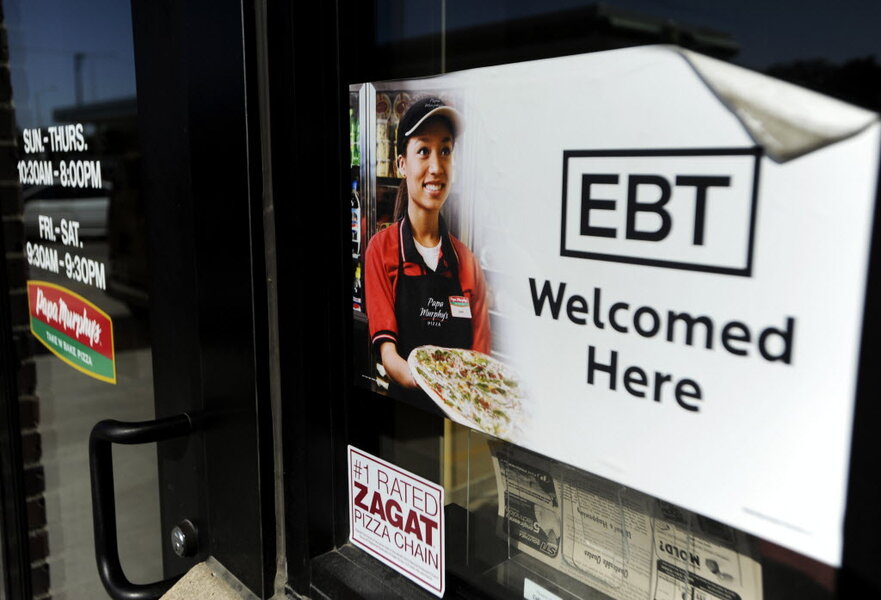Food stamps: why cuts affecting 48 million Americans begin Friday
Loading...
Millions of Americans will be expected to make do with less as of Friday, as $5 billion in cuts to the US food stamp program takes effect. The cuts to the program, formally called the Supplemental Nutrition Assistance Program (SNAP), will pinch almost 48 million people and could be followed by an even bigger slash.
The cuts come as a four-year increase in funding to the food stamp program reaches its expiration date. Government support for the program had been increased in 2009, as part of the broad stimulus package designed to help strapped Americans piece back together what had been lost during the recession.
The food stamp cuts, scheduled to take effect on Nov. 1, are distinct from possible additional slashes to the program included in the farm bill – broad legislation covering America’s agriculture and nutrition policies, including the food stamp program. The House version of the bill calls for a reduction in spending on food stamps by $40 billion over the next decade. The Senate is proposing less-significant cuts of about $4 billion.
The end to the food stamp provisions in the stimulus program will reduce government spending some $5 billion in the 2014 fiscal year. The impact that the funding curtailment will have on people receiving benefits will depend on household size. For a family of four receiving a maximum food stamp allotment, benefits will decrease from $668 to $632 per month, a decrease of $36, the US Department of Agriculture (USDA) said.
The cuts come at a time when more Americans are on food stamps than at almost any other point in the past decade. In fiscal year 2006, about a year before the recession, the number of people on food stamps was about 26 million. As of this July, the most recent month for which data are available, almost 48 million people are enrolled in the program, or about a seventh of the US population.
In 2009, noting the burgeoning numbers of Americans who had lost their jobs, homes, or both, Congress passed the American Recovery and Reinvestment Act. The set of measures, including a now-lapsed payroll tax “holiday,” was modeled on the idea that helping struggling Americans find their footing again could help jump-start an entire community’s economy: Each dollar in food stamp benefits generates about $1.70 in economic activity, according to Moody’s Analytics.
If counted as income, food stamp benefits lofted some 4 million Americans above the poverty line in 2012, according to the US Census Bureau and USDA’s Food and Nutrition Service. About 83 percent of food stamp benefits go to households that include a child, a senior, or a disabled person, according to Feeding America.
But the swelling number of enrollees in the program, and rising government expenditures for it, furnished a Republican push for major cuts to food stamps. The program has doubled in cost since 2008, now amounting to some $80 billion per year, the Associated Press reports.
In September, the Republican-controlled House passed a farm bill that would drop almost 4 million people from the food stamp program, according to the Congressional Budget Office. The bill, in aiming to tighten the eligibility requirements for the program, would require adults between 18 and 50 without dependents to be either employed or enrolled in a work-training program to receive benefits. It would also allow states to require food stamp recipients to be subjected to drug testing, as well as eliminate the automatic enrollment of people who qualify for other low-income benefits.
"By reforming food stamps, we will save the program for the truly needy," Rep. Virginia Foxx (R) of North Carolina told Reuters. "An overextended, unchecked SNAP program won't be capable of serving the citizens it's purposed to help."
About 400,000 people would be removed under the Democrat-controlled Senate’s bill, according to Feeding America. Negotiations between the two chambers began Wednesday.
Anti-hunger advocates have said that food stamp benefits are seldom enough to support struggling families month to month, even before Friday’s cuts and the proposed cuts under either version of the farm bill.
“We already know SNAP doesn't last the whole month,” Rebecca Brislain, executive director of the Florida Association of Food Banks, told NPR.
Food stamp eligibility is limited to households with gross income of no more than 130 percent of the federal poverty guideline, or an income of about $2,552 a month. About 90 percent of households receiving the benefits fall well below that level, according to Feeding America. The average household on food stamps has a gross monthly income of about $744, the group says.






